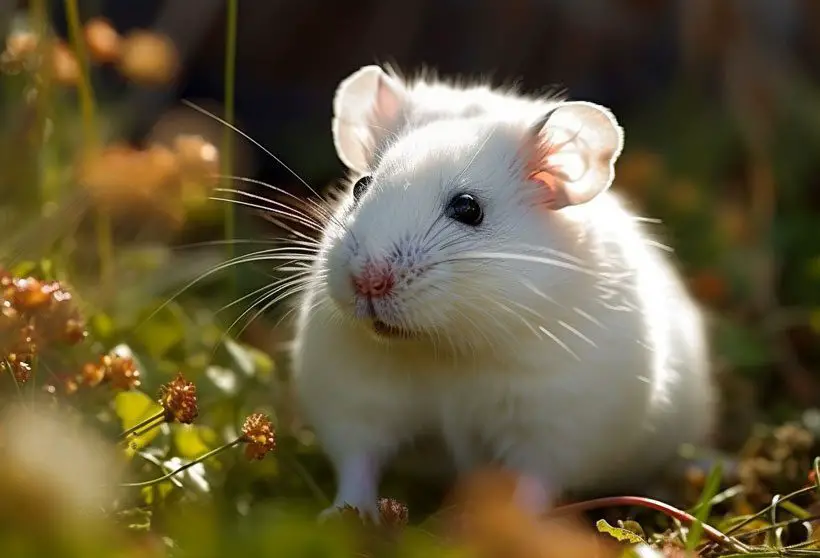How To Tame A Hamster? 4 Steps to Follow Without Getting Bitten
Most new hamster owners can’t wait to handle and interact with their new pets. Not only does this slow down the taming process, it actually scares the furry creatures. Hence, following the right steps can make taming your hamsters much easier.
But how to tame a hamster? Taming a hamster is a 2-phase process. First, you bring a hamster to your house, and second, you make it feel comfortable with you. Feeding the hamster, giving it treats, letting it listen to and smell you – all of these measures you can take to tame your pet. And patience is a must here.
In this guide, we’ll talk about how you can tame a hamster and create a good bond with your little companion. Stay tuned and keep reading.
How To Tame A Hamster?
Taming a Hamster is mostly about patience and consistency throughout the process. We’ll first talk about what you should know before taming a hamster. And then dive into the steps of the taming process.

Things To Keep In Mind Before Starting To Tame A Hamster
Let’s look at 3 things you should take care of before trying to tame your hamster.

1. A Willing Hamster
A willing hamster means a hamster that’s in the mood to be tamed. For example: try to play and interact with your hamster when it seems the most active. It’s better to leave it alone while taking a nap or resting.
2. Clean Hands
Wash your hands before touching the hamster, especially if you’re going to touch it after you’ve had a meal. Do this because if your hands smell of food, the hamster may confuse them with food and try to bite it.
3. Cage Size
Nobody feels good inside a cramped space. Even though a hamster is a small creature, it still needs a lot of room to move and play. Get a properly sized cage for your hamster. The cage shouldn’t need to be too large, but it should be spacious enough to move the hamster freely.
There should be a comfortable bed as well as thick bedding. All of these factors play a vital role in a hamster’s behavior.
4. Toys
Being inside a cage isn’t fun. This builds up stress inside the hamster’s little mind. Get it toys to play with them and an exercise wheel so it may get some exercise to ease the pent-up tension.

With access to these, your hamster will have somewhere to spend its energy and feel distressed.
Taming A Hamster In 4 Steps
Following are 4 steps that you can follow to tame your hamster easily in a short period of time.
Step 1: Let It Stay Uninterrupted
- Don’t go near it for at least the first 2-3 days after bringing home your hamster and putting it in the cage. It will be already stressed after moving from the breeder’s house to the pet shop and then moving to your place from the shop.

So, letting it stay uninterrupted for some time makes it get adjusted to the new environment.
- Also, don’t try to have its attention initially.
- Give it food, change its bedding and replace its litter daily.
- Clean the cage but don’t hold or touch your new pet yet. Hamsters do take a few days before they start feeling comfortable.
Step 2: Respect Its Sleeping Cycle
Only interact with the hamster when it seems to be in a playful mood. It’s a good idea to avoid interacting with it in the evening and night time. Daytime is best for playing with it.
If you disturb it during its resting time, you’ll disrupt its sleep cycle and you’ll have to train its sleep cycle again. Moreover, it will delay your taming process.
Step 3: Begin To Interact With Your Hamster
After the first 2-3 days, your hamster should start feeling more comfortable around you.
- Now you can slowly start talking to it. Just sit beside its cage and speak anything to it in a peaceful voice. The main goal here is to make it comfortable with your voice.
- You should, at this stage, start feeding it with your hands. Hold a piece of food near the cage and let the hamster come naturally to grab it.
- Don’t open the cage completely and reach for it as this may scare the tiny animal. Just wait and your furry pet will come for your hands as these animals are very curious.
Step 4: Start Touching It
Once the hamster starts feeding from your hands, you can slowly start touching it.
- But first, don’t just go grabbing it. Put your hand inside the cage and go near the hamster. Slowly get the back of one of your palms near it.

Why the back? Because in this way, the hamster won’t be able to bite your fingers. The back of the palms is a flat area, unlike fingers, hard to bite.
- Touch it and it’ll then start to sniff your hand. If the hamster tries to nibble, move your hand, but slowly. Don’t rush.
- Slowly you should now open up your palm and let the hamster come on your palm. If the hamster feels too careful at this point, you can put some treats on your hand. It’ll get attracted by the food and reach for your hand.
Step 5: Make It Comfortable In Your Hands
- Don’t take your hand high yet as the hamster may feel scared. Keep your hands on the ground level and keep cupping it.
- Once you realize that your furry friend feels comfortable with you cupping it, you can then take it higher or move it from its cage while playing.
Consistency Is Key
Unlike dogs, hamsters aren’t readily tameable. These are small creatures with small brains, hardly sit still and always trying to run from here to there. Once you’ve tamed your pet, try to get daily interaction with it so that it doesn’t forget you.
And be patient. Depending on the breed, a hamster can take weeks to feel comfortable around its owner. For example, dwarf hamsters are known as hard to tame. Nevertheless, if you put in enough time, any breed of hamster can be tamed. Consistency is the major condition here.
Taming Is A Continuous Process
The more you spend time playing games with your hamster and giving treats, the more attached it’ll be to you. As you build a deeper bond, you can start to teach it tricks and games. The more tamed a hamster is, the easier it is to teach it things and help it build habits.

FAQs
Take a look at these frequently asked questions for further clarification on the hamster taming process.
Q: How Long Does It Take To Tame A Hamster?
Initially, you can expect it to feel comfortable to play with you in the first week or so. Complete taming can take a few weeks to a month or more, meaning it can spend extended periods of time with you.
Q: Is It Easy To Tame A Hamster?
It’s not too hard, nor it’s easy. Unlike dogs and cats, hamsters are considerably harder to tame. But if you’re patient, you can expect your hamster to slowly get attached to you. With time, the bond becomes strong.
Q: How To Tame A Scared Hamster?
You need to be a bit more patient while taming a nervous hamster. You can hand-feed your hamster, give it treats and lightly touch it to make it less scared.
Final Words
Hopefully, now you’ve got the basic ideas of taming a hamster. These furry creatures are fun to watch in their cages. They’re playful and can be trained in some tricks if the bonding with the owner is right. That’ll only happen if you treat your furry companion right, which you know how to do now.
On top of that, patience and consistency with tips and tricks are a must. Hamsters are sensible and fragile. Every step you take has to be with extra care and attention.




